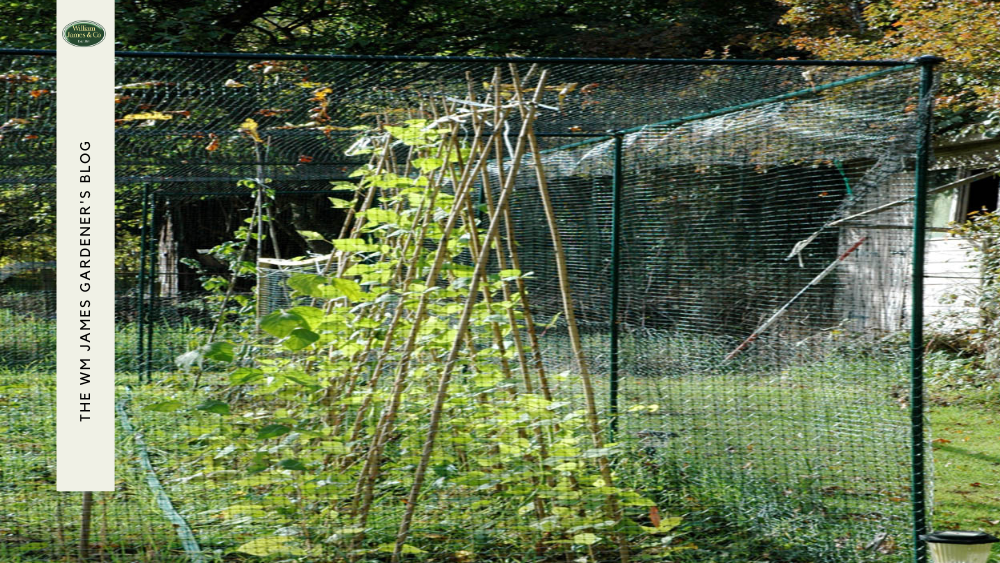We use cookies to make your experience better. To comply with the new e-Privacy directive, we need to ask for your consent to set the cookies. Learn more.
How to Grow Blueberries from Seed in 8 Simple Steps
- Admin
- WM James Gardening Blog
- 5 Dec 2024
-
449views

Thinking about dabbling in home-grown fruit? Blueberries are a great choice for UK gardeners! If you want to know how to grow blueberries so they’re plump and delicious, our guide has everything you need.
Not only do blueberries add some diversity to our diets, but the shrub itself is actually a lovely addition to your garden. From the foliage to the sweet fruit, it’s a win-win situation.
To get started on growing these delicate berries, you’ll need to make sure you have all the right tools and equipment.
Pots, trays, compost, spades, and netting are all essentials in a blueberry-growing arsenal.
We’ve picked out the tools that we use below, so you can grab them straight away before heading into the steps (plus, you can enjoy free delivery* when you shop with WM James!).
It is worth noting, though, that you’ll need a little patience with these guys – blueberry plants take around 2-3 years to fully establish and start producing fruit.
But don’t let that put you off because once they get going, they can keep producing for up to 50 years! It’s a shrub you can take real pride in and show off to your friends and family.
In This Guide:
Understanding the Basics of Blueberries
What Do You Need to Plant Blueberries: Tools & Equipment
Step 1) Choose Your Blueberry Seeds
Step 2) Form the Blueberry Seeds
Step 3) Prepare for Planting Blueberry Seeds
Step 4) Sow the Blueberry Seeds
Step 5) Transplant the Blueberry Seedlings
Step 6) Harden Off the Blueberry Plant
Step 7) Caring for Your Blueberry Plant
Step 8) Harvesting Your Blueberries
Conclusion: Growing Blueberries for a Nutritious & Delicious Harvest
Understanding the Basics of Blueberries
Before starting, it's important to note that blueberries thrive in acidic soil (pH 4.5-5.5) and prefer well-drained and moist conditions.
They also require full sun to produce an abundant harvest, but they can tolerate some shade (thank goodness, otherwise, this UK climate would make it difficult for the little fruit!).
We know we've already mentioned it, but we'll say it again in case you've got your hopes up for a quick harvest...
Growing blueberries from seeds can take up to three years before you have any fruit to harvest. It's a long-term project for gardeners who enjoy that kind of thing!
How to Plant Bare Root Fruit Trees
What Do You Need to Plant Blueberries: Tools & Equipment
Here's everything you'll need to grow your blueberries from seeds:
- Fine sieve
- Sealable plastic bag
- Potting seed trays
- Soil pH testing kit
- 30cm pot (wide and deep)
- Compost scoop
- Ericaceous liquid feed
- Ericaceous compost
- Sand/perlite
- Spade
- Mulch
- Anti-bird netting/ fruit cage
- Watering can
- Garden pruners
Note: Ericaceous might be a gardening term you’ve already heard, but just in case, it just refers to products that acid-loving fruits and veg need in order to thrive.
Step 1) Choose Your Blueberry Seeds
The first step in planting your blueberries is, of course, choosing your seeds!
There are many varieties to choose from, but Bluetta and Sunshine Blue are commonly recommended as the best for containers and small gardens.
From Fresh Blueberries
If you want to get experimental, use seeds from fresh blueberries (propagating); here's what you should do:
- Buy organic, ripe blueberries.
- Mash the blueberries into a bowl and fill it with water. Stir the mixture to loosen up the pulp.
- The viable seeds will sink to the bottom, while the pulp and unviable seeds float. Skim off the top layer and pour the remaining mixture through a fine (very fine!) sieve to collect the seeds.
- Dry the seeds on a paper towel for a day or two, then pop them into a seed packet envelope to keep them safe.
From Seed Packets
Purchasing pre-packaged seeds from a trusted supplier is an easier way of getting your blueberry seeds, and they will ensure high germination rates.
But this method isn't as DIY-y, which many gardeners enjoy!
Step 2) Form the Blueberry Seeds
Blueberry seeds often require cold ‘stratification’ (which is a fancy word for ‘forming’) to encourage germination. Here's how it's done:
- Place the seeds on a damp paper towel and fold it. Place this inside a sealable plastic bag.
- Store the bag in the freezer for around 90 days.
- This will break the seeds' 'rest period', so they're ready for planting.
Step 3) Prepare for Planting Blueberry Seeds
While your seeds are busy stratifying, you have some time to prepare everything you need for planting your blueberries. Here's what you should do:
- Get your potting trays and ensure they've got sufficient drainage holes.
- You'll need to fill these with an acidic medium because blueberries love a medium-low pH level. To do this, mix ericaceous compost with sand or perlite for optimal drainage. You can get pH level testers if you want to be sure of your acidic medium.
Step 4) Sow the Blueberry Seeds
When the 90 days are up, it's time to sow your seeds! Here's how to grow blueberry plants in pots:
- Fill your containers with your pre-made acidic medium.
- Scatter the seeds over the surface, taking care because blueberry seeds are teeny tiny.
- Cover the seeds with a very thin layer of compost – about 3-4mm.
- Mist the surface lightly with water to avoid displacing the seeds.
- Place your containers in a warm, bright location like a windowsill or greenhouse.
- Keep the soil moist but not waterlogged. Germination can take 4-8 weeks, so being patient is key.
Our Rowlinson Potting Store has dual functionality, with a greenhouse area for potting and growing and a large storage area! Perfect for caring for your blueberries.
Step 5) Transplant the Blueberry Seedlings
When your blueberry seedlings have 2-3 sets of true leaves and are large enough to handle, they can be transported to individual pots. Here's how it's done:
- Prepare your 30cm pots with fresh acidic medium using a compost scoop for ease.
- Carefully lift the seedlings to avoid damaging their delicate roots.
- Plant each seedling in its own pot, ensuring the roots are fully covered with soil.
- Water gently after transplanting and continue to do so to keep the surface moist. Try to use rainwater, as tap water can increase your soil pH over time.
- Pots should be kept in a sunny spot indoors.
- Feeding-wise, use an ericaceous liquid feed during the growing season to promote healthy development.
Step 6) Harden Off the Blueberry Plant
Once the risk of frost has passed, it's time to 'harden off' your young blueberry plants so they are strong enough to move outside. This is the process of hardening off your plants:
- Hardening off is the gradual process of acclimatising your plants by placing them outside for a few hours each day, increasing exposure over 1-2 weeks.
- Once they've gone through this process, they'll be ready to plant outside! Choose a sunny, sheltered spot with acidic, well-draining soil. If your garden's soil isn't suitable, consider planting in a raised bed or larger pot.
- Use a spade to dig a hole slightly larger than the root ball, place the plant inside, and fill again with your acidic medium. Space the plants about 1 metre apart.
Step 7) Caring for Your Blueberry Plant
You need to pay some attention to your blueberry plant now it's living outdoors, so here are some things you need to consider to keep your blueberry plants thriving:
- Apply a layer of organic mulch, like pine bark or wood chips, around the base of the plants. This will help retain moisture, suppress weeds, and maintain acidity.
- Continue using rainwater over tap water where possible. Use a watering can that allows for even water flow.
- Protect your plants using anti-bird netting or grow them in a fruit cage to prevent pesky beaks from eating the fruits as the plants mature. You can't go through this process for nothing!
- Prune annually anytime from November to March (they may not need it in the first few years) by removing dead or weak branches to encourage airflow and healthy growth.
Step 8) Harvesting Your Blueberries
Patience is a virtue with blueberries, and you will be rewarded with a bountiful harvest for years to come (eventually) if you follow our steps!
Harvesting usually occurs in June, August, and September. Just remember they won't all be ripe at the same time, so check your plants repeatedly during these months.
The first harvests may be small, but with proper care, the yield will increase over time.
A Guide to Eating UK Seasonal Fruit & Veg
Extra Tips for Growing Blueberries at Home
Along with the steps we’ve laid out above, there are some extra tips that can help you successfully grow blueberries at home.
- You should aim to re-pot your blueberry plants every 2-3 years.
- Blueberries are hardy plants, but it is a good idea to protect young plants from extreme frosts with a fleece or move pots to a sheltered spot.
- Avoid planting blueberries near vegetables like tomatoes and potatoes, which prefer neutral or alkaline soil.
Conclusion: Growing Blueberries for a Nutritious & Delicious Harvest
There you have it! With patience and consistent care, you can enjoy homegrown blueberries fresh from your garden.
While you’re waiting for your blueberries to establish themselves, why not get busy growing strawberries, raspberries or blackberries? You can create your very own homegrown berry patch that’s ripe and ready to pick throughout the summer months.
For more help and advice on sowing and planting, please feel free to contact us! With over 60 years in the horticultural industry, we are more than happy to help!
*Free and fast UK delivery is free on orders over £100!
FAQs
How Long Does It Take for Blueberries to Grow?
Blueberry plants take at least 2-3 years to produce fruit. Once established, they can provide a harvest for 30-50 years. Patience pays off with a lifetime supply of blueberries!
Are Blueberries Easy to Grow in the UK?
While not the easiest fruit for beginners, blueberries can be grown in the UK with some preparation. Once set up, they mostly need occasional watering. For easier options, try growing strawberries first.
Where is the Best Place to Plant Blueberry Bushes?
Blueberry shrubs thrive in spots with a mix of sunlight and shade. They prefer well-drained, acidic soil that retains moisture, making them ideal for carefully prepared gardens.
Is it Best to Grow Blueberries in Pots?
If your garden soil isn't acidic, pots are a great alternative for blueberries. Use a pot at least 30cm wide and deep, with drainage holes to prevent waterlogging.
When is the Best Time to Plant Blueberries?
Blueberry bushes can be planted year-round as long as the ground isn’t frozen. For the best results, aim for planting during January, February, June, November, or December.

















